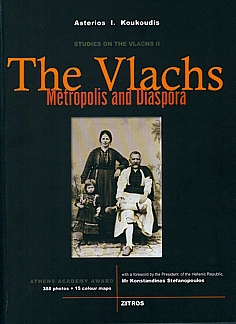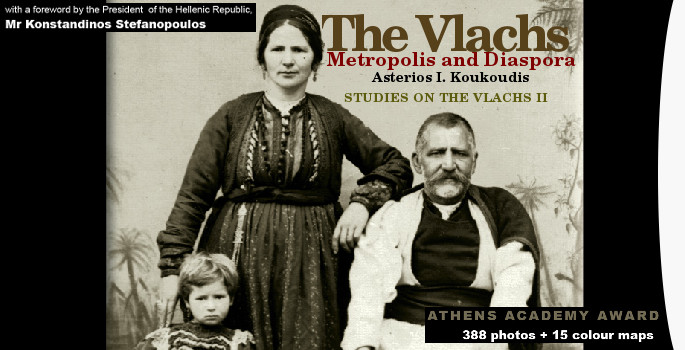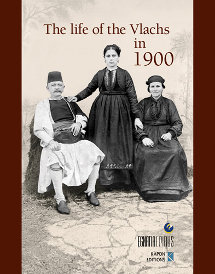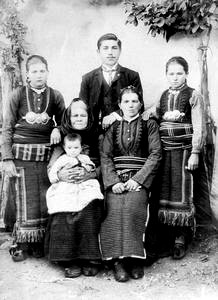
The Vlachs: Metropolis and Diaspora
Studies on the Vlachs - 2nd vol.
hard cover 28x21 cm
516 pages, 15 colored maps
388 old black and white pictures
Zitros Publications, Thessaloniki 2003
Foreword by the Director Yannis Z. Drossos
Foreword by the Director of the Institute for Defence Analysis Yannis Z. Drossos
In this, the second volume of the four-volume series Studies on the Vlachs, Mr Koukoudis looks at the Vlachs’ ancestral villages and conducts a detailed investigation of their exoduses from those villages and their diaspora throughout the Balkans. It is an investigation that leads to an alternative approach to the Vlach identity. The study of the Vlachs is not the study of a perpetual, discrete linguistic group, but the history itself of the gradual and variable Latinisation and de-Latinisation of the southern Balkans. Shifting populations and diaspora have been constant features of the Vlachs’ history, as has their Latinate speech.
Around the landmark year of 1769, when Moschopolis suffered its first collapse, the Vlachs began their best attested dispersion northwards. Groups both large and small left their ancestral homes along the spine of the Pindos Mountains for the furthermost reaches of the Balkans and even beyond. They inundated Macedonia, creating new villages in the highlands and colonies in the developing towns and cities, and travelling as far as the flanks of the Rodopi and the western Balkan Mountains and the urban centres of Bulgaria. They established communities in towns in Kosovo and Serbia. They crossed the Danube and the Sava and swelled the ranks of the Greek Orthodox communities in the Habsburg Empire and the Danubian Principalities. Mr Koukoudis’s account and record of the dense Vlach diaspora demonstrates that Greece itself is the indisputable ‘metropolis of the Vlachs’.
His research demolishes a number of myths and fictions. It demonstrates that in the modern period the Vlachs were not a marginal group of traditional mountain-dwelling transhumant stockbreeders. Although their roots as stockbreeders go back to the Middle Ages, the nomadic and semi-nomadic herdsmen were only one part of the Vlach mosaic. From the beginning of the seventeenth century, when the Vlachs began gradually making their presence felt in the Balkans, they appeared both as traditional mountain-dwelling transhumant stockbreeders (and by extension as thoroughly capable fighters, armatoles, and klefts) and as urban traders, craftsmen, professionals, and retail merchants (and by extension as agents of economic and intellectual activity). These pages make it clear that it is the Vlachs’ recent past that has been most important and played the biggest part in defining their identity.
Particularly in their ancestral homes in the Pindos and the offshoots of the Pindos, the identical modern history of the Vlach-speakers and Greek-speakers, their joint participation in the armatoliks, the War of Independence of 1821, and the subsequent rebellions throughout the nineteenth century, the Vlachs’ leading role in economic and cultural affairs, their shared development, and their political identification left little scope for disruptive tendencies to take root. Despite the interventions of various outsiders, the Vlachs are still part of the Balkan dimension of Romiosyni and of modern Greece. Ultimately, irrespective of their linguistic identity, the historical evolution of the Vlachs themselves confirms the osmotic relationship between the Greek-speaking and the Vlach-speaking populations and shows how trite and indefensible it is to regard them as a minority.
With the fixing of the borders in the Balkans, from 1912 onwards the vast majority of the Vlachs became Greek citizens, as well as integral members of the modern Greek nation. With very few exceptions (such as the once splendid Moschopolis), almost all the ancestral Vlach homelands along the Pindos are an inseparable part of Greece itself. In contrast to the demographic picture of the Vlachs in the surrounding Balkan countries, in contemporary Greece the ancestral highland villages of all the Vlachs co-exist with a great number of more recent Vlach settlements in the plains and in the urban, economic, and administrative centres from Thrace to Roumeli.
This study, objective and impartial, blazes a new, much smoother trail for research into the Vlachs and helps to develop and consolidate a calm, bona fide scientific debate.
So I am delighted to welcome the second volume in Mr Koukoudis’s four-volume series on behalf of the Institute for Defence Analysis, which supports and encourages the writing of scholarly studies and publications on major issues in modern Greek history.
Yannis Z. Drossos







